¶ Genealogy materials on Claes Vijgh and his children. (in development)
At
the left is a 2009 aerial photo of Aldenhaag. We can clearly see the round island
of the first castle, despite the heavy tree cover. To the left of Aldenhaag
and just above the planted field, are the two small rectangular hills with a
moat between them that were the original entrance of Aldenhaag. Water, coming
up under the trees at right and then bending left, would have surrounded both
the castle and the second hill (or island), making this a double drawbridge
fortification. Zoelen itself is also such a castle today. Knights in armor had
a most difficult time in deep water, even when the moat was fairly narrow, and
in the Middle Ages few could swim.
Below the old castle island is a large home that today is known as the Soelen house. The 18th century pictures also show such a structure there and there most likely was one in the time of Claes Vijgh as well. If so this would have been the “or Aldenhaag’ site the Spanish thought the two Calvinists of 1574 might have been at. Since Zoelen came to the Vijghs after Aldenhaag, and Claes was already Lord of Aldenhaag, then there has to have been a house there if it was his country estate near Tiel before he obtained Zoelen.
At
left is a 2009 aerial view of Zoelen Castle in the summer. This is where one
would enter the grounds of Zoelen and Aldenhaag. Note at the left the large
number of sheep (white dots) in the meadow. Although the Netherlands made much
of its early wealth with sheep — thus the Golden Fleece — and still
have large numbers they seldom appear in Google photos. But here, at Zoelen,
they are clearly evident.
I often wondered why this little, dirty, metal sheep (for that was how Willem saw it) was such an important omen for him that he remarked on it and kept it all his life. Now that we see how often sheep are around Zoelen and Aldenhaag, it was likely so that day too. Choosing to pursue bio dynamic agriculture, then coming to a pleasant spot through flocks of sheep, and finally finding a tiny metal sheep there would indeed reinforce the idea of it being a sign of correct choice. It has also been suggested that perhaps they strolled around there because it was a somewhat mysterious spot in the woods (remember the tomb of the Baron), and this could itself enhance the symbolism of the little ram in the ground.
On page 179 and page 181 it is mentioned two times that Claes Vijgh is a knight in the order. In translation it says: (p.179):
"That day the first stone of the foundation (in which a cross, and the day and year of the foundation was carved) was laid by the vigorous Nicolaas Vyghe, ambtman of the Nederbetuwe and judge of the town of Tiel, who a year before in Gent was dubbed a knight in the Order of the Golden Fleece by his majesty Philip, King of Spain and Duke of Gelre. Because of the honour given to him he [=Claes] donated to the construction-supervisor and the other workmen two golden crowns French money and one silver half-a-crown.
Nicolaas Vijghe, knight in the Order of the Golden Fleece and Ambtman of the Nederbetuwe, donated 20 silver half-crowns, in order to buy chalk . . . etc."
On page 181 it says:
"On March 1563 the vigorous Nicolaas Vyghe, knight in the Order of the
Golden Fleece and judge of our town, and several other member of the
magistrate, started building the orphants house."
As I document the appearance of the standing ram in contemporary, or near contemporary, portraits we must be careful to not place too much significance on the use of any particular decorative form in the paintings. Even the wealthy had few portraits painted, and were usually appointed to the Order of the Golden Fleece late in life. The common practice was to have an artist paint a Golden Fleece on the existing portrait, and many are so awkwardly done that it is an obvious addition. In such cases it is much less likely that the artist saw the fleece of the patron and only copied, from memory or comparison, the fleece shown on an earlier painting. Such practice could become a fashion and so maintain a style that was, if fact, long since discarded in real objects. Thus, although there are numerous 17th century portraits that show a standing ram fleece I have only seen one — that shown on the opening page of this article. Similarly, although there are a number of 18th century French portraits and busts showing standing rams, not a single fleece of this type is known from the 18th century. We can, however, generally trust the evidence of a large number of art works showing the same style, as well as the evidence of gradual change from one style to another.
From the left: a three dimensional Spanish plaque showing Charles V with a plump standing ram; Charles V with a standing ram fleece from a painting by Franz Franken II of the abdication of Charles V in 1555, but painted c. 1620; and a portrait by Moro of Emperor Maximillian II, the nephew of Charles V, wearing an essentially standing ram fleece that is starting to show the squeezing of the top back into a skin.
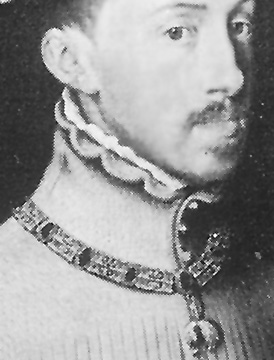
For the time of Philip II we find, below from the left: A portrait of Philip II in 1555 by the Titian school where he wears a standing ram on a double link gold chain; an engraving from the Netherlands of Philip in 1572 wearing a standing ram fleece, this time on a wide (and presumably red) ribbon; and a standing ram in a 1580 portrait worn on an intertwined red ribbon and gold chain.
Below these in the second row, from the left: a standing ram fleece in a 1580 portrait of Philip II; a transitional fleece in a 1590 portrait of the aged Philip II, where the stiff legs of the standing ram and a more upright head are balanced by a thinning in the middle and the fat, tear drop shaped wooley legs of the baroque appear; and then, a 1570s engraving of the Duke of Alba wearing, yet again, a standing ram fleece.
In the third row of photos is a Dutch engraving from the late 1560s of the nemesis of Alba and the Spanish, William the Silent, Prince of Orange. Here, he too wears a plump standing ram fleece on the usual red ribbon, just as does Alba, showing the general use of this style across the Habsburg world, from Spain to the Netherlands and beyond. To the right of William the Silent is a standing ram fleece worn by his son Prince Philip William of Orange (known then as “Orange”), and dating to after his 1599 appointment to the order. This seems to show a later usage in the Netherlands than elsewhere for the standing ram and a family continuity of its use through several generations for the Egmond-Orange line. And at the far right are the Imperial arms on the front of the Toll House in Bruges, where the Hapsburgs lived for some time, and it shows a clear standing ram.
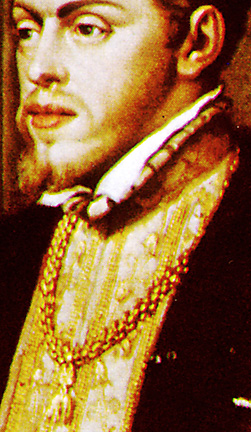
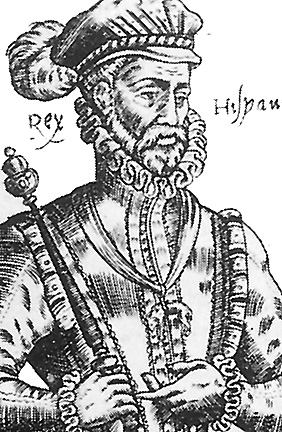
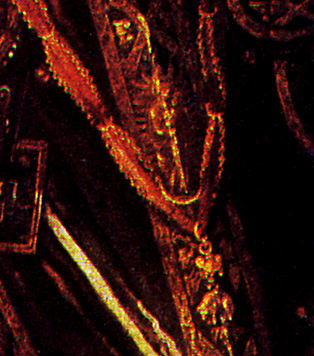
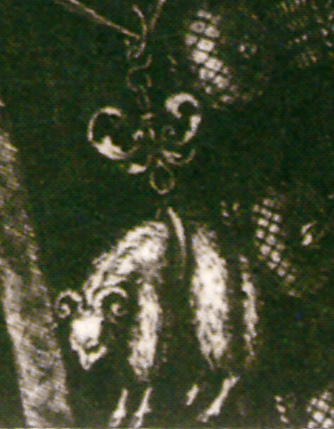
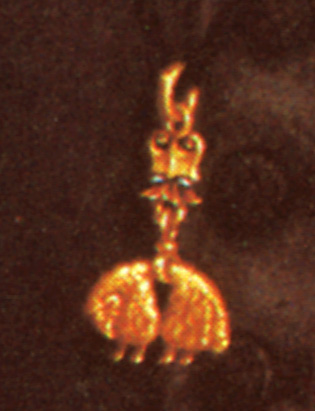
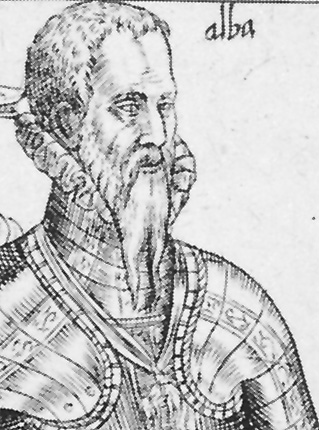
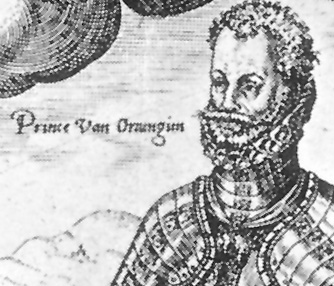
In
a c. 1490 Württemburg allegorical heraldic decoration in a manuscript (seen
at left) is a Golden Fleece collar with a standing ram — one of the
earliest known depictions of this fleece type. The collar elements and the rope-like
attachment for the fleece are similar to those seen on the collars of the Imperial
family in the first half of the 16th century.
Sixteenth century coinage, from the left: Sigismund II of Poland silver ort, John II Casimir of Poland silver ort, below these are Henry Duke of Brunswick-Lunebourg (1555-1568) silver thaler and Reichsguldiner.
The
chapel plate seen at right is for Wilhelm von Rosenberg, a wealthy Prague burger,
at his tomb at the Church of St. Vitis in Cesky Krumlov where a standing ram
is on his plate outside the chapel of Saint Jan Nepomuk. The fleece form should
reflect either that given him in 1585 by Philip II, or a local form developed
about this time for Rudolf II. This use of the standing ram in Bohemia seems
to start with the coming of Rudolf II in 1585. Rudolf is frequently shown wearing
seemingly antique family standing ram fleeces, and the form thereafter shows
up in both the Czech lands and Poland. It is interesting to note that although
Rudolf II was the heir to the Austrian lands and spent much of his youth at
the court of Philip II, he was not raised to the Golden Fleece until 1585, when
he came to the throne at the age of 53! Although he was sent a collar by Philip
II, and it was sent back by courier on Rudolf’s death as required, Rudolf
seems, in his antiquarian passion, to have also used many antique family fleeces
from the treasury and so spread the standing ram form throughout central and
eastern Europe in a second flush of usage. In his castle at Cesky Krumlov there
is also an oil painting of von Rosenberg wearing a standing ram fleece on a
collar, and which can be briefly seen on the Rick Steves travel video The
Czech Republic Beyond Prague.
A
distinctive and very late standing ram use of c. 1681, although certainly reproducing
design forms determined a generation or two earlier in the Palatinate military.
This is a Leibstandard of a cavalry regiment of Kurprinz von der Pfalz Johann
Wilhelm, Stadthalter of Düsseldorf. It likely arose with the regiments
raised for the 30 Years War, and so dates more to 1620-40, falling at the end
of the use of the standing ram.
In
France, as we have mentioned, the standing ram form reappeared when Philip V
of Bourbon became king of Spain. Either new fleeces were made in the old style
to imitate those found in the Spanish treasury and worn by Philip V, or the
artists depicting them looked to an ancient model for their compositions. At
left we see the painted fleece on a mid 18th century portrait of Louis XV of
a type that was reproduced in quantity and distributed to other rulers and French
embassies. From a noted American collection. I have seen several other
18th century French portraits of the king wearing such a fleece, from Louis
XV to Louis XVIII. We should note that I have not seen a single 18th century
French fleece, in collar or bijou, that was this type; they are seen only in
the contemporary paintings and sculpture of the royal family. This may be a
timely reminder that art and life do not necessarily see things the same in
form, style or detail.
At
the right is the much worn fleece at the bottom of an Austrian type 1767 military
cap badge that was used until 1804, although this shape of badge was for a kasket
and is before 1792. From some archive the standing ram was used again, two hundred
years after it was discontinued as a form for the fleece on the order itself.
In
the portrait at left, of a young member of the Golden Fleece painted by Martin
van Mytens the Younger in the early 18th century, we see his collar has a standing
ram —a very late usage if real, but certainly one more piece of documentation
suggesting it could be so.
And in an interesting twist there are the modern re-introductions of the standing ram fleece in corporate and government trademarks and arms. Brooks Brothers uses the standing ram fleece for their logo, and say it was because of its earlier use by British and Flemish wool merchants. And in Georgia, the ancient land of Colchis, the two towns of Poti and Shorapani have placed a fine standing ram Golden Fleece (Okros Satsmisi in Georgian) on their coat of arms (seen below). At the far right below is a “golden fleece” and dragon set up in Sochi in a further attempt to gain attention through the country’s mythical past, but here it looks like the ram is being tortured.
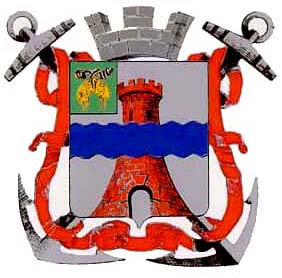
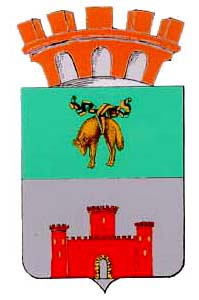
II. The Hamlets of Thedinghsweert & Zoelen-Aldenhaag
III. The van Egmonds, Claes Vijgh & The Golden Fleece
IV. The Standing Ram Fleece & Charles V
Appendix 1. The Standing Ram Fleece As Seen in the Insignie Orden Book & Other Catalogs
Appendix 2. Other Scholars Look At the Aldenhaag Fleece
Appendix 3. Greek & Roman Mythology of the Golden Fleece
3B. Classical Texts That Mention the Golden Fleece
May 2010 Meeting on the Aldenhaag Fleece — 1. The Places
May 2010 Meeting on the Aldenhaag Fleece — 2. The Fleece
Return to Society of the Golden Fleece
Return to the Golden Fleece Insignia Page
Antiques AtoZ Home Page
Medals, Orders
& Decorations